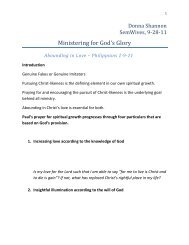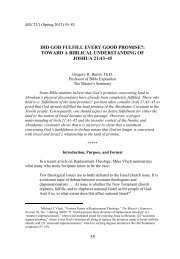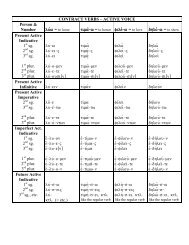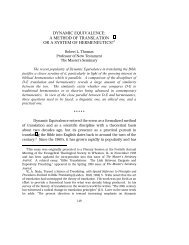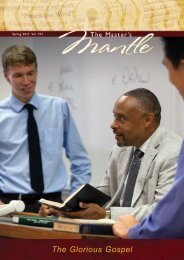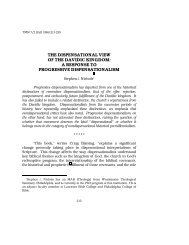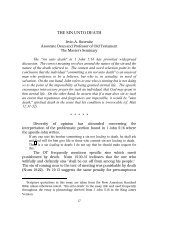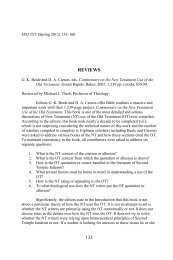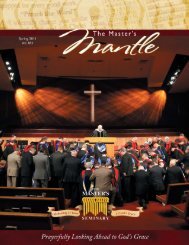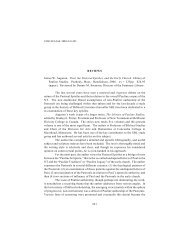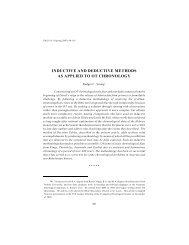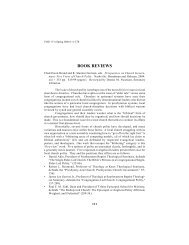Book Reviews for 1:2 - The Master's Seminary
Book Reviews for 1:2 - The Master's Seminary
Book Reviews for 1:2 - The Master's Seminary
- No tags were found...
Create successful ePaper yourself
Turn your PDF publications into a flip-book with our unique Google optimized e-Paper software.
has the strongest and most persuasive presentation of the nonlordshipside. For those who believe the debate is about little morethan semantics, Belcher presents a convincing case otherwise.<strong>The</strong> author fairly represents both parties, deals with issues andnot personalities, evidences clear thinking, writes well, and isthorough and well organized. <strong>The</strong> book has three sections: (1) apresentation of both sides, (2) a comparison of the sides, and (3) acritique of the non-lordship side. In the final section, he points out sixstraw-men used by Hodges in representing the lordship position, sixmajor exegetical errors of Hodges, and six telling theological errors inHodges's work.Belcher strives <strong>for</strong> objectivity throughout and achieves his goalcommendably. Yet with intellectual honesty, he does not shun majorconclusions, based on a thorough biblical evaluation.To the best of this reviewer's knowledge, Professor Belcher hasno personal axe to grind, so his conclusion is very significant. AboutHodges's position, Belcher says, "Yet as this author has studied thelogic, the exegesis, the arguments and statements of Hodges in hisbook, it has been concluded that the non-lordship position he presentsis based on straw-men, exegetical inaccuracies, flawed theologicalthinking, and some illogical and unbelievable statements" (p. 71).In contrast, about MacArthur's view he writes, "This writerwants to go on record that though he is in strong agreement withMacArthur in the basic tenets of his book, that does not necessarilymean he agrees with every statement that MacArthur makes or a levelof emphasis he gives each issue in his book. . . . It is a valuable andwell written and challenging book, but certainly not infallible" (pp.105-6).While Belcher has not commended MacArthur <strong>for</strong> perfection,he has clearly concluded that MacArthur is biblically on target andHodges has missed the mark widely. Belcher by his incisive surveyhas contributed significantly to the theological literature written <strong>for</strong>laymen. He understands that few untrained Christians will even readMacArthur or Hodges and fewer will understand the issues. Thisreviewer recommends Belcher's book to all who are confused by theissues or have yet to grapple with them.202
<strong>Book</strong> <strong>Reviews</strong> 203Sidney Greidanus. <strong>The</strong> Modern Preacher and the Ancient Text. GrandRapids: Eerdmans, 1988. 341 pp. $19.95 (paper). Reviewed byDavid C. Deuel, Associate Professor of Old Testament.Sidney Greidanus is professor of theology at <strong>The</strong> King'sCollege, Edmonton, Alberta. <strong>The</strong> present work, an outgrowth of theauthor's doctoral dissertation, "brings together the results of recentbiblical scholarship as they pertain to preaching, and . . . links thedisciplines of biblical hermeneutics and homiletics" (p. xi), a link that isbadly needed today.<strong>The</strong> present volume seeks not only to unite hermeneutics andhomiletics but also, within the field of hermeneutics, to link historicaland literary studies. Greidanus writes, "Biblical studies has recentlyentered a new world: it has undergone a paradigm shift fromhistorical to literary studies" (p. xi). He recognizes that such a shiftpresents some "precarious hazards" but some "exciting possibilities" aswell (p. xi). Having read the literature, the author observes that"scholarly interest today is focused not so much on history as ongenres of biblical literature`with a concomitant shift in homiletics to<strong>for</strong>ms of sermons" (p. xi). But he also sees the necessity of keepinghistorical controls in order to retain objectivity.<strong>The</strong> author not only advocates expository preaching but alsocarefully defines what the expression means so as to avoid confusing itwith topical preaching. To refute the commonly held conviction thattopical preaching may also be called biblical preaching, the authorargues, "One might say that expository preaching is preachingbiblically. But `expository preaching' is more than a mere synonym <strong>for</strong>biblical preaching; it describes what is involved in biblical preaching,namely, the exposition of a biblical passage . . ." (p. 11).Greidanus proposes an interpretive methodology that seeks tounderstand a passage in its historical and cultural context withoutignoring the literary dimension, which was also part of the author'sintention, or the canonical referents which compose the broadercontext of the book. Having defended his method in chapters twothrough four, he discusses theological interpretation`the only basis <strong>for</strong>application (p. 121). <strong>The</strong> biblical message must be "a word from Godand a word about God" (p. 120). Through this theological objective thesermon achieves its purpose.One of the most helpful discussions <strong>for</strong> pastors, and at the same
204 <strong>The</strong> <strong>Master's</strong> <strong>Seminary</strong> Journaltime perhaps one of the most controversial, tells how to identify aliterary unit in Scripture. How large a text does the nature of apassage require a preacher to take? Besides the artificial boundaries ofverse, chapter, and in some instances even book divisions <strong>for</strong> textualunits, what other criteria isolate a textual unit? In answering thisquestion, the author differs with Yoder's (From Word to Life) view thatthe paragraph is the smallest organized unit, arguing "the Biblecontains both smaller and larger thought units than paragraphs" (p.127). On the one hand, the sentence in prose and the line in poetry aresmaller textual units; on the other hand, the biblical author may dealwith a single major point in a lengthy narrative.Citing his agreement with Yoder, Greidanus concludes thissection by recommending that the preacher ask questions of the text:"Is the goal of the unit reached? Is the story finished, the tensionresolved, or the topic completed?" (Greidanus, p. 128, quoting Yoder,p. 57).Other guidelines <strong>for</strong> isolating a textual unit may be the literaryconstructions employed by the biblical writer, such as chiasm,inclusion, or other parallel structures (p. 133). <strong>The</strong> author giveshelpful hints on how to identify and use these structures.Every preaching text (complete literary unit) has a theme`atruth that may be expressed in propositional <strong>for</strong>m. A literary unit isan independent thought unit, a thematic unit. Yet not all agree thatthis equation covers all types of biblical texts, such as narrative, <strong>for</strong>example. <strong>The</strong> author considers the pros and cons of thematic-textualpreaching and concludes with this advice: "<strong>The</strong> text's theme should be<strong>for</strong>mulated from the author's viewpoint and not that of differentcharacters in the text . . ." (p. 135).After a discussion of the sermon's <strong>for</strong>m and relevance,Greidanus suggests how one should preach from the major literarygenres found in the Bible: Hebrew narratives, prophetic literature, theGospels, and the epistles. Greidanus's work is not a "how to" text inhomiletics. He does offer many helpful suggestions regarding sermonpreparation, but the strength of the book is its relative breadth ofresearch and consistent hermeneutical system.But perhaps this strength may also be its major weakness: inspite of the 340 pages of rather small print, the breadth of issuescovered may leave some readers dissatisfied. So many theoreticalgivens receive attention that some questionable ones are neither
<strong>Book</strong> <strong>Reviews</strong> 205sufficiently explained nor critiqued. <strong>The</strong> author anticipates thiscriticism and responds,One of the risks in writing on this subject is that, because of theknowledge explosion, one spreads oneself too thin. . . . Whatencouraged me to carry out this broad inquiry is that preachers cannotbe experts in all of these areas and yet they need to be knowledgeableabout them in order to preach responsibly (p. xi).<strong>The</strong> writer defends his work by noting that he has taught courses inmany of the areas and has solicited the help of "experts in history,literature, systematic theology, and Old Testament, New Testament,and homiletics, as well as some pastors and church members" (pp. xixii).In short, this is a helpful treatise on Greidanus's method ofsermon preparation. Readers will question some of the principles, butthe book meets the need <strong>for</strong> a relatively comprehensive analysis ofresearch from both hermeneutics and homiletics and from writers whohave sought to bridge the gap between the two. This reviewer highlyrecommends the book to those who wish to evaluate some difficulthermeneutical and homiletical assumptions behind our interpretationand preaching, particularly of the OT.Michael Horton (editor), <strong>The</strong> Agony of Deceit. Chicago: Moody, 1990.284 pp. $12.95 (cloth). Reviewed by Richard L. Mayhue, Professorof Pastoral Ministries.This courageous volume confronts the errant theology thatdominates Christian television. Well-known conservatives such as R.C. Sproul, Walter Martin, and C. Everett Koop are among thecontributors. <strong>The</strong> book will undoubtedly be the most significantanalysis of teaching on Christian television to date.<strong>The</strong> teaching ministries of Kenneth Hagin, Kenneth and GloriaCopeland, Fredrick K. C. Price, Paul and Jan Crouch, Jimmy Swaggart,Robert Schuller, Robert Tilton, and Earl Paulk receive the most space.Though they teach widely and have access to anyone watchingTV, popular teachers are rarely (if ever) accountable to anyone exceptthemselves <strong>for</strong> the scriptural accuracy of their teaching. This book
206 <strong>The</strong> <strong>Master's</strong> <strong>Seminary</strong> Journalattempts to make them answerable <strong>for</strong> what they teach.Using documentation from the books of these people and tapesof their programs, the contributors are systematic in exposing theirmajor Scriptural errors. This book is not just a mild invitation <strong>for</strong> theseto reconsider their positions. Rather, it severely labels their fallacies as"heresy." For example, C. Everett Koop writes, "When a faith healercommands God to per<strong>for</strong>m a miracle, in the absence of a prayer thatsays, `Thy will be done,' it is, as far as I am concerned, the most rank<strong>for</strong>m of arrogance" (p. 176).Reputable evangelical leaders have now publicly in<strong>for</strong>med the"positive confession" movement, the "ye are little gods" advocates, theself-esteem teachers, the faith healers, and the "health and wealth"hucksters that their teachings have decisively wandered from thehistoric Christian faith.<strong>The</strong> book should assume a role alongside Walter Martin'sclassic <strong>The</strong> Kingdom of the Cults in educating the Christian public andprotecting them from doctrinal error trying to enter their homes viatelevision.Michael J. Hostetler. Introducing the Sermon: <strong>The</strong> Art of CompellingBeginnings. Grand Rapids: Zondervan, 1986. 89 pp. $5.95(paper). Reviewed by David C. Deuel, Associate Professor of OldTestament.This is a book by a pastor designed to help other pastors withsermon introductions. After quoting advice from several greatpractitioners of homiletics, the author concisely builds his own case <strong>for</strong>a carefully planned sermon introduction: "If the introduction falters,the exposition may never be heard" (p. 12). This raises a host ofquestions, five of which are posed and answered in chapter one:"What is the purpose of an introduction?," "Is an introduction alwaysneeded?," "How long should the introduction be?," "Must I write it?,""How about unconventional introductions?"In the second chapter Hostetler proposes four "contact points"essential to every sermon introduction: the secular, the biblical, thepersonal, and the structural. He writes, "Omit the secular and youstand a good chance of losing the audience be<strong>for</strong>e you really get
<strong>Book</strong> <strong>Reviews</strong> 207started. Omit the biblical and you have nothing to say. Omit thepersonal and the sermon drifts over the listeners' heads and out theback door. Omit the structural and your audience faces a rough rideto an unclear destination" (pp. 25-26). He continues, "No contact, nostart. Your precious sermon, reflecting hours of diligent Bible studyand careful organization, will evaporate into the rafters of the churchbuilding unless its introduction makes contact with the secular world,the Bible, the needs of people, and the main body of the sermon. Don'tsettle <strong>for</strong> two or three of these contact points. Go <strong>for</strong> all four" (p. 85).Chapter three recommends placing the secular contact pointfirst because the preacher must first lead his listeners from their worldto Scripture. Though sermon preparation moves from Scripture toapplication, sermon delivery must lead the listener to the text instages. Otherwise, he may never arrive there. <strong>The</strong> congregation needsto hear a very explicitly stated "contact point" first, ideally one directlyfrom the biblical text.Opening lines are critical, but the author perhaps overdoes it inoffering eight pages of typical first lines to be avoided. He dividesthese into four categories: biblical, religious, historical, and referential.He finds all of these deficient in comparison to secular contact points.Chapter four deals with secular contact points and is weak in failing toallow <strong>for</strong> different audience tastes. Some listeners prefer one or moreof the four opening sentence types ruled out by the author. Hostetlergeneralizes too much about audience interests and about the universalappeal of a secular contact point.Because even secular contact points may fall flat, the sermon'sopening line must generate interest or curiosity. Two litmus tests <strong>for</strong>the opening-line effectiveness are specificity (detail) and relevance.Specificity of detail creates sharper images in the minds of listenersand enhances the speaker's credibility, but too much detail is counterproductive,dulling the interest of the listener.<strong>The</strong> relevance of an opening line is measured in two ways:appropriateness to the sermon's biblical content and relationship to theaudience. <strong>The</strong> subject of the sermon must guide the choice of a contactpoint. Awkwardness and confusion in transition from introduction tosermon body results from an unrelated initial statement. "You need toestablish an initial contact with the text in the introduction in order todemonstrate how and why the sermon really is biblical" (p. 57).In a series of sermons the introduction can both introduce the
208 <strong>The</strong> <strong>Master's</strong> <strong>Seminary</strong> Journalindividual sermon and link it with the preceding and followingsermons. Chapter six proposes several principles to aid in makingtransitions in a sermon series.To accomplish personal contact, the topic of chapter seven, oneshould address universally felt needs of people. Yet the particularneeds of subgroups within the congregation should not be ignored. Infact, the sermon should use the second-person pronoun to be"downright personal." If the sermon does not so engage the listenersregarding their sins and failures, their fears and hopes, "it is both ahomiletical and a pastoral failure" (p. 68).To ensure secular, biblical, and personal contact, the sermon'sintroduction must be packaged so as to take the listener from hisworld to the Bible. In view of this, the final chapter addresses anothercritical issue, the transition into the sermon's body. This structuralcontact point bridges the gap between the introduction and theindividual points of the sermon through the proposition, the sermon'smain idea. While on the one hand the introduction "does notdetermine what the main points will be, . . . it does greatly affect howthey will be described" (p. 81).Several statements of the author need clarification. Inmaintaining that "Bible lectures need introductions as do sermons," theauthor argues, "Though often passed off as sermons, they [Biblelectures] are different in both purpose and thrust. <strong>The</strong> Bible lecture isessentially educational. Its primary purpose is to explain the biblicaltext. <strong>The</strong> sermon, on the other hand, is essentially motivational. It usesthe explanation of the text as the basis <strong>for</strong> a personal or corporateresponse to God" (p. 13). Hostetler's main purpose <strong>for</strong> this dichotomyis to emphasize the need <strong>for</strong> an introduction to Bible lectures, but in sodoing, he establishes a rigid distinction between sermons and Biblelectures and omits a category of sermons whose objective is botheducational and motivational. In fact, one could question the existenceof a worthy motivational sermon that does not educate or a worthyBible lecture that does not motivate.<strong>The</strong> author dislikes historical introductions, contending that theolder the historical data, the less interesting it is. This is not altogethertrue. Much depends on how historical in<strong>for</strong>mation is presented. Oldhuman problems repeat themselves and provide a framework <strong>for</strong>examining contemporary struggles. David's struggles with sin are notunlike our own.
<strong>Book</strong> <strong>Reviews</strong> 209Hostetler's primary emphasis on bringing the congregationfrom their world to the Bible's is refreshingly sensitive. <strong>The</strong> bookechoes John Broadus' timeless wisdom regarding sermonintroductions: "Our aim should be to excite not merely an intellectualinterest, but, so far as possible at the outset, a spiritual and practicalinterest" (Broadus, A Treatise on the Preparation and Delivery of Sermons,p. 267).H. Wayne House. <strong>The</strong> Role of Women in Ministry Today. Nashville:Thomas Nelson, 1990. 192 pp. $9.95 (paper). Reviewed byRichard L. Mayhue, Professor of Pastoral Ministries.<strong>The</strong> co-chairman of the Council on Biblical Manhood andWomanhood provides a comprehensive biblical appraisal of thecontemporary issues related to the role of women in the local church.Most of his positions agree with those of <strong>The</strong> <strong>Master's</strong> <strong>Seminary</strong>faculty. Like House, we disagree with the statement from Christians<strong>for</strong> Biblical Equality (CT, April 9, 1990, pp. 36-37) that allows womenthe role of doctrinal and worship leadership in the church.<strong>The</strong> author has studied extensively, thought carefully,assembled material logically and comprehensively, and writtenclearly. <strong>The</strong> book reflects his studies at Abilene Christian Universityand teaching at Dallas <strong>The</strong>ological <strong>Seminary</strong>.He does not divide his book into sections, but four areas ofthought are apparent: contemporary Christian feminism (chaps. 1-2),women in the NT and NT times (chaps. 3-4), women in the second andthird century church (chap. 5), and the biblical role of women in thechurch today (chaps. 6-9).House asserts correctly that the raison d'=etre of thiscontemporary issue has little to do with biblical exegesis. Rather, itstems from the influence of secular feminism on the church (pp. 11, 14,159, 161). Not all who are sympathetic toward the Christian feministmovement agree with all the tenets of secular feminism, but theyespouse its general spirit that role equality is a must <strong>for</strong> our day. BothHouse and <strong>The</strong> <strong>Master's</strong> <strong>Seminary</strong> strongly believe this to be out ofharmony with biblical teaching regarding women's role in the church.Key topics covered well by House include the purpose of
210 <strong>The</strong> <strong>Master's</strong> <strong>Seminary</strong> Journalcreation (1 Cor 11:9), the order of creation (1 Cor 11:8; 1 Tim 2:13), andthe nature of the fall (1 Tim 2:14) (pp. 26-27). He discusses significantsections on "headship" (pp. 29-34, 109-112) that clearly support thebiblical teaching of male leadership. <strong>The</strong> word <strong>for</strong> "head" does notmean "source" as alleged by the "equality of role" position.Galatians 3:28 (pp. 100-7) teaches redemptive equality, not roleequality, according to House. He also treats 1 Cor 14:33-35 and 1 Tim2:8-15, concluding, "Paul's prohibition on teaching is specificallydirected toward the authoritative exercise of spiritual authority, suchas that of an elder, of women over men" (p. 139).One major flaw slightly tarnishes an otherwise fine work. On 1Cor 11:1-16, House concludes that "public prayer by a woman of thecongregation should be no less enthusiastically received in publicprayer than by a man" (p. 124). He also allows <strong>for</strong> the public readingof Scripture by women. Yet he redeems himself somewhat with astrong concluding statement: "<strong>The</strong> ministry of authoritativelyexpounding and proclaiming the Written Word is one that falls mostdefinitely within the confines of biblical restriction <strong>for</strong> women."House's work is not so much reactionary as it is proactive. Hisconcluding chapter, "Where May Women Minister in the ChurchToday?," first discusses the doctrinal and leadership roles of male onlyelders, then the role of deaconesses, and concludes with a helpfulsection on principles to use in establishing women in ministry.<strong>The</strong> author has wide documentation from literature written onboth sides of the issue. His "Notes" and Bibliography are marred bythe misspelling of Nancy Hardesty's name ("Herdesty") (p. 189). <strong>The</strong>volume is enhanced by an extensive Scripture index (pp. 190-92).This excellent one-volume summary on women in ministryfrom a biblical perspective is most useful <strong>for</strong> serious laymen,seminarians, and pastors.Robert L. Hubbard, Jr. <strong>The</strong> <strong>Book</strong> of Ruth. Grand Rapids: Eerdmans,1989. 317 pp. $26.95 (cloth). Reviewed by David C. Deuel,Associate Professor of Old Testament.<strong>The</strong> author introduces his commentary with a detailed andcomprehensive analysis of canonicity, literary criticism, authorship
<strong>Book</strong> <strong>Reviews</strong> 211and date, purpose, setting, genre, legal background, themes, theology,analysis of contents, and selected bibliography.Because much of the secondary source material on the book ofRuth has been written in German or French or appears in scholarlyjournals, it is inaccessible to pastors. Hubbard, Professor of Hebrew atDenver <strong>Seminary</strong>, has rectified this situation with his newcommentary. He not only explains such details as the alleged genderdisagreements (following Gary Rendsberg) as common duals, but alsodelves into compositional issues such as the book's unity, including thegenealogy that concludes the book (Ruth 4:18-22). Although the firstverse of the book (1:1) places the story chronologically within theperiod of the judges, the genealogy (again assuming the book's unity)puts the composition during or subsequent to David, but pre-exilic.<strong>The</strong> author has carefully brought together much recent researchon the literary dimension of Ruth and included with this his ownliterary analysis of the book.Two themes intertwine, tying together both the book's storyline and its concluding genealogy: God's gracious rescue ofElimelech's family from extinction and Ruth's journey from Moabitessto ancestress of King David (pp. 63-64). <strong>The</strong> author contends that inspite of its secular appearance, the book speaks inferentially of thepresence and faithful activity of God as He controls the course ofevents leading from disaster to deliverance.Hubbard's commentary offers the Bible student a wealth ofresearch and personal insight into an OT book whose timeless messageoften receives too little attention. <strong>The</strong> reviewer highly recommendsthe book to those interested in a careful analysis of Ruth.Kent and Barbara Hughes, Liberating Ministry from the SuccessSyndrome. Wheaton: Tyndale House, 1987. 204 pp. $9.95 (cloth).Reviewed by Richard L. Mayhue, Professor of Pastoral Ministries.Anyone in the ministry who has grappled with depressionand/or perceived failure will identify with Kent and Barbara Hughes'sdiary of trying times in ministry. Currently pastoring College Churchin Wheaton, Illinois, Kent, along with his wife, Barbara, chronicle theirexpectation of outward success in ministry that ran aground in the
212 <strong>The</strong> <strong>Master's</strong> <strong>Seminary</strong> Journalshoal waters of unexpected ministry reversals. After following all thepragmatic principles of church-growth experts with their promise ofsuccess, they discovered that their flock had dwindled rather thangrown.<strong>The</strong>y write candidly about unbiblical hopes that almost causedthem to leave the ministry. In the midst of despair, they reconsidered"the book" on ministry, Scripture. In a down-to-earth style, they tell oftheir redefinition of success (chaps. 3-10) and the sources of theirencouragement (chaps. 11-15) that helped lift them to sustaining levelsof joy and a more biblical definition of ministerial fruitfulness.Particularly good are helps from the pastor's wife and thecongregation that complete their discussion. This is must reading.While the book may have its greatest use as preventative, <strong>for</strong> thosealready in "the slough of despond" it could be a lifesaver.John M. Lozano, Praying Even When the Door Seems Closed. New York:Paulist, 1989. 183 pp. $9.95 (paper). Reviewed by James E.Rosscup, Professor of Bible Exposition.<strong>The</strong> Catholic author has taught theology and <strong>for</strong>ms of prayer<strong>for</strong> years. He wants to help strugglers who approach prayer as abarred door that they must overcome to get answers, therebysometimes developing wrong attitudes about God (p. 1). He hassections on such topics as Prayer as Conversation, Prayer andIntimacy, Jesus Prays, Prayer and Faith, Prayer and God's Will,Praying in the Blood of Christ, and Prayer at Work.Some comments are helpful. Lozano says that Origen took theexhortation to pray without ceasing "as an exhortation to live ourwhole life and work as an implicit prayer" (pp. 56-57). What he saysabout meeting God in the rush hour and in ministry, using times ofintense activity to be in a spirit of prayer (pp. 58-59) is good. He seesall proper prayer as a response to the Word of God (p. 72). Chapterseven, which deals with mystics, tells experiences of some Catholics infeeling God's presence.Certain statements are strange and do not communicate well.For example, "a radical interiorization to the point of findingourselves, beyond ourselves, in the infinite being who creates us" (p.
<strong>Book</strong> <strong>Reviews</strong> 21312). Later Lozano explains this as becoming aware of God's presence(p. 13). It would have been simpler to say this in the first place. Somestatements seem unwise or at best need qualifications, e.g. "God is ineach person we meet, behind each object we desire, in the depths ofevery action we per<strong>for</strong>m" (p. 41).Another puzzler is, "If every neighbor is an image and a son ordaughter of God, those who are oppressed, humiliated, wounded,abandoned, hungry, ignorant, subject to constant insecurity, etc., are soin a particular way" (p. 49). Does this agree with Scripture? Again,Lozano writes, "We may not exactly know whether Moses saw a bushthat burned without being consumed, because the burning bush maywell be a metaphor to indicate religious experience" (p. 50). Where isthe contextual indicator that this is a metaphor? Later we read: "No,we don't have to pray expressly <strong>for</strong> all the needy. Even when we don'tinvoke God's grace in so many words <strong>for</strong> those who suffer, we are stillinterceding <strong>for</strong> them. All we have to do is stand like beggars be<strong>for</strong>eGod and look at God with humility, or simply to kneel be<strong>for</strong>e thecrucified, because praying is always interceding" (p. 52). How can thisbe true?On p. 54, the wording seems to make nature itself God. ForJohn of the Cross, "God is the nearby hills, the farthest mountains ofthe Sierra Nevada, the shady valleys. . . . But God is also the exoticbeauty of the distant islands. . . ." This is just a careless use of words,because later Lozano distinguishes God as Creator from His creation(p. 55). Another perplexing statement is, "We pray <strong>for</strong> those we serve,even when we don't mention them expressly, because we immerseourselves in God and God enriches us through them" (p. 61).<strong>The</strong> author approves the fathers' allegorizing of the Song ofSolomon by having the bride represent the Christian in search of theWord, Christ, and marriage with God (pp. 67-68). <strong>The</strong> writing styleoften does not stimulate practically, as in Lozano's discussion of hisfirst three degrees of prayer, i.e. reciting <strong>for</strong>mulas learned from others,meditation, and prayer in pouring our affection to God (pp. 73-82).Some statements have departed from clarity into a dense fog:e.g. if one feels dryness in prayer and cannot meditate or expressaffections, God is just preparing him <strong>for</strong> a stage in which He will do thepraying. <strong>The</strong> person will feel invaded by powerful <strong>for</strong>ces from within(pp. 88-89, 101). This is just subjective opinion, and does not offersatisfying help. Many readers will ponder whether to try to figure the
214 <strong>The</strong> <strong>Master's</strong> <strong>Seminary</strong> Journalchapter out or seek a better book.Chapter 8 on "<strong>The</strong> Higher Degrees of Prayer" recommendsvarious techniques. An example is St. Bernard's idea of three degrees(p. 131): kissing Christ's feet (conversion), hands (ascetic progress),and mouth (contemplation). <strong>The</strong> experiences may help some readersand disturb others. Some of the latter type claimed "visionsaccompanied by images and . . . conversations with supernaturalbeings" (p. 142).Chapter 10 on fullness of love theorizes that prayer canprogress to a final degree, a trans<strong>for</strong>ming union with God. Gal 2:20 isused <strong>for</strong> this (p. 161). Is not Gal 2:20 Paul's conversion experience and,in some measure, the experience of every Christian even if he has notexperienced the maturity and consistency of life in Christ? Lozanosees God's grace penetrating the believer progressively "until it unitesour being with the divine being" (p. 164). Is not every true Christianunited with God from the moment of regeneration, with a process ofsanctification in God's grace from there on?<strong>The</strong> book has its better moments in offering practical help, butis far down the list of books that will help motivate and instructChristians on effective prayer. It vividly illustrates how little help awork by a non-evangelical can contribute to an evangelical in therealm of practical Christian living.Larry W. Osbourne, <strong>The</strong> Unity Factor. Dallas, TX: Word, 1989. 156 pp.$11.99 (cloth). Reviewed by Richard L. Mayhue, Professor ofPastoral Ministries.Leadership Journal polled pastors with the question, "Whatcauses you to feel discouraged in ministry?" Nearly <strong>for</strong>ty percent ofthe respondents answered, "Board meetings." To meet this obviousneed, Larry Osbourne, pastor of North Coast Evangelical Free Churchin Oceanside, Cali<strong>for</strong>nia, writes from his own experiences.Why worry about unity? According to Osbourne: (1) Ifleadership is not unified, the flock will be divided. (2) It is impossibleto sustain spiritual growth without unity. (3) Because unity is sofragile, it constantly needs attention.In his twelve chapters, Osbourne assumes a biblically based
<strong>Book</strong> <strong>Reviews</strong> 215theology and builds on it practical discussions ranging from thepragmatics of meeting location to establishing the pastor's salary.Each chapter stands alone, but together they all contributeconstructively to eliminating common sources of disruption.Several discussions stand out. Leadership selection (chap. 3),clarifying the pastor's role (chap. 5), a basic philosophy <strong>for</strong> preaching(chaps. 8-9), and change diplomacy (chap. 10) all help make <strong>The</strong> UnityFactor "must" reading <strong>for</strong> every pastor and elder-level leader in thechurch.Robert L. Reymond, Preach the Word. Edinburgh: Ruther<strong>for</strong>d House,1988. 89 pp. $4.95 (paper). Reviewed by David C. Deuel, AssociateProfessor of Old Testament.<strong>The</strong> author is a professor of systematic theology andapologetics at Covenant <strong>The</strong>ological <strong>Seminary</strong> in St. Louis. This workoriginated as a series of lectures to ordained ministers and ministrycandidates of the Church of Scotland at Ruther<strong>for</strong>d House, Glasgow,Scotland, in 1986. Reymond's introduction argues,Never has the need been greater <strong>for</strong> Spirit-anointed preachers who canstand in the pulpits across the world and with power "rightly handle"the unsearchable riches of the Word of God (p. ix).He expresses concern over the subtle tendency of ministerialcandidates to focus on the "practical matters" of the pastorate to theexclusion of the real priorities:But in his zeal to become an effective administrator or personnelmanager, the ministerial candidate must never neglect to acquire and tohone to a razor-sharp edge his biblical-theological skills, <strong>for</strong> it is thisarea of his training above all others which will provide him the contentof his message and which will even determine in large measure thedegree to which his preaching, teaching, and counseling ministry will betrue to God's Word and taken seriously by those who hear him (p. ix).In light of this concern, Professor Reymond's first chapter addressesthe need <strong>for</strong> a scripturally based theology. Because revelation is"in<strong>for</strong>mational" by nature (pp. 14-15), the two testaments exhibit a
216 <strong>The</strong> <strong>Master's</strong> <strong>Seminary</strong> Journal"unitary wholeness" (p. 1), and the "Bible is the inspired, infallible,inerrant Word of God to men" (p. 3), a pastor "will have to be able torespond as his spiritual <strong>for</strong>ebears did be<strong>for</strong>e him [to those who objectto such a position] with careful research and accurate exegesis" (p. 3).In this regard, the author challenges two common objections:"religious truth will always be existential truth" (p. 3) and "humanlanguage is incapable of expressing literal truth" (p. 9). His detailedresponse to both objections is bold and clear: Scripture ispropositional truth and is capable of conveying the intentions of God.He concludes:This propositional or in<strong>for</strong>mational revelation the preacher must makethe bedrock of the instructional aspect of his ministry if he would have ateaching ministry approved of God, <strong>for</strong> it is only as he teaches andpreaches truth originating from God Himself that he can speak withauthority and demand that his audience do what he says (pp. 14-15).Several erroneous challenges underscore the need <strong>for</strong> a"rational" theology. <strong>The</strong> first is that "God's knowledge and man'sknowledge never coincide at a single point" (p. 17). <strong>The</strong> second is"Christian truth will often, if not always, be paradoxical in appearance"(p. 27). Reymond's response to both objections may be reduced to thesimple premise that revelation is eternally self-consistent or noncontradictory(p. 34)."Every preacher will have either a God-centered or a mancenteredtheology" (p. 36). <strong>The</strong> author's third chapter <strong>for</strong>cefullyappeals <strong>for</strong> the <strong>for</strong>mer. A God-centered theology affirms both the totalsufficiency and sovereign control of God and the total insufficiencyand, by implication, lack of control by man. This chapter respondsprimarily to the question, "If this [the above] is the case, men areneither free nor responsible agents" (p. 39). Because Clark Pinnock'sposition on this issue is objectionable, Reymond responds specificallyto Pinnock.<strong>The</strong> fourth and final chapter builds on conclusions from the firstthree: the Bible is propositional truth, conveying the very intentions ofGod; truth revealed is eternally self-consistent (non-contradictory) andis both systematic and God-centered. <strong>The</strong> need <strong>for</strong> a ministry toarticulate the system of belief found in Scripture is the topic of thischapter. It may be summarized as follows: "Only when the church istaught what it is to believe, and obeys what it has been taught, will it
<strong>Book</strong> <strong>Reviews</strong> 217manifest the glory of God and enjoy Him and His blessing as itshould" (p. 74).Reymond's book is well written and organized. It clarifiesseveral areas of confusion that confront churches and pastors almostdaily. <strong>The</strong> reviewer recommends the book particularly <strong>for</strong> thosestruggling with the nature of God's Word and the manner in which toapply it in the believer's life.One typographical oversight needs correcting: "meets" (p. 4)should be "meet."Leland Ryken, Worldly Saints: <strong>The</strong> Puritans as <strong>The</strong>y Really Were. GrandRapids: Zondervan, 1986. 281 pp. $18.95 (cloth). Reviewed byDavid C. Deuel, Associate Professor of Old Testament.<strong>The</strong> author, an English teacher at Wheaton College, initiallyexpresses a threefold purpose <strong>for</strong> his book: (1) to correct an almostuniversal misunderstanding of what the Puritans really stood <strong>for</strong>, (2)to bring together into a convenient synthesis the best that the Puritansthought and said on selected topics, and (3) to recover the Christianwisdom of the Puritans <strong>for</strong> today (p. xvii).By returning to original sources, Ryken both addresses andrefutes some of the unjust allegations against the Puritans, such as theywere against sex, they never laughed and were opposed to fun, theywere opposed to sports and recreation, they were money-grabbingworkaholics who would do anything to get rich, and they were hostileto the arts.J. I. Packer in the <strong>for</strong>ward similarly responds to criticism ofearlier Puritan scholarship and expresses appreciation <strong>for</strong> Ryken'swork in which "at last the record has been put straight" (p. x). Packerargues, "<strong>The</strong> typical Puritans were not wild men, fierce and freaky,religious fanatics and social extremists, but sober, conscientious, andcultured citizens, persons of principle, determined and disciplined,excelling in the domestic virtues, and with no obvious shortcomingssave a tendency to run to words when saying anything important,whether to God or man" (p. x).Having restricted the definition of "Puritan" to a movement ofthose adhering to "Puritan religion" (p. xviii), Ryken explains
218 <strong>The</strong> <strong>Master's</strong> <strong>Seminary</strong> Journal 218Puritanism as a social and historical phenomenon. In order tofacilitate the understanding of how seventeenth century Puritanismcame into existence, he provides a helpful time-line on which helocates a few Puritan antecedents and some of the landmark dates inPuritan history.In chapter two the book begins a topical <strong>for</strong>mat that continuesthrough chapter ten. In these chapters the author discusses the Puritanperspectives on work, marriage and sex, money, family, preaching,church and worship, the Bible, education, and social action.<strong>The</strong> chapter entitled "Puritan Preaching" is a detailed picture ofthe Puritan pulpit ministry. Pastors will delight both in the model ofteaching ministry espoused and its pervasive effect on the home life.Specific discussions include Puritan expository preaching, sermonorganization, practical application of doctrine, affective preaching, andstyle of preaching.Chapter eleven, "Learning from Negative Example: SomePuritan Faults," adds a necessary touch of realism to a book defendingPuritan integrity. <strong>The</strong> author summarizes, "We find it easy to admiretheir courage, their faithfulness to God and the Bible, theireffectiveness in changing the course of history. But we also sense theirremoteness from us, their somewhat <strong>for</strong>boding austerity, their rigidity,and their tendency to be looking <strong>for</strong> an argument" (p. 186).In the final chapter, Ryken <strong>for</strong>sakes the topical <strong>for</strong>mat to"attempt an anatomy of underlying principles . . . each of which wouldapply to a whole cluster of earlier topics" (p. 205). After the analysis ofdivergent topics (chaps. 2-10) this chapter is a satisfying conclusion inintegrating "the entire book into a unified final impression" (p. 205).Twentieth-century evangelicals may learn several significantlessons from the Puritans: "the integration of their daily lives; . . . thequality of their spiritual experience; . . . their passion <strong>for</strong> effectiveaction; . . . their program <strong>for</strong> family stability; . . . their sense of humanworth; and . . . the ideal of church renewal" (pp. xi-xv).Ryken's sensitive use of language adds to his grasp of thePuritans and their times to make the book pleasurable reading. <strong>The</strong>wealth of quotations from numerous Puritan writers on various topicsestablish this as a welcomed resource <strong>for</strong> the pastor searching <strong>for</strong>challenging quotations and illustrations. <strong>The</strong> craft with which theauthor weaves together these gems of wisdom and examples iscommendable.
<strong>Book</strong> <strong>Reviews</strong> 219J. A. Thompson, Handbook of Life in Bible Times. Downers Grove:InterVarsity, 1986. 384 pp. $34.95 (cloth). Reviewed by Richard L.Mayhue, Professor of Pastoral Ministries.Thompson writes to show how the reality of life underlies thenarrative of the Bible from Genesis to Revelation. <strong>The</strong> book hastwenty-two chapters arranged under seven sections: (1) Introduction;(2) People at home; (3) Food and drink; (4) Industry and Commerce;(5) Culture and Health; (6) Warfare; and (7) Religion.This storehouse of helpful background material is easilyaccessed through indices by place, people, and general references.Relevant biblical references to a subject frequently fill the margins. Atthe end of each chapter the author provides a bibliography <strong>for</strong> furtherreading.Pictures, drawings, and maps enhance the written discussions.This is one of the more complete, helpful, and easily usable volumes ofits kind. With a minimum investment of time, the book can be atreasured companion yielding frequent rich rewards <strong>for</strong> an overloadedpastor.Jerry Vines, A Guide to Effective Sermon Delivery. Chicago: Moody,1986. 170 pp. $12.95 (cloth). Reviewed by Richard L. Mayhue,Professor of Pastoral Ministries.This prominent Southern Baptist leader, pastor of First BaptistChurch, Jacksonville, Florida, writes on a neglected topic: the scienceand art of sermon delivery. Vines exhibits the passion of a pastor whofaced the prospect of surgery on his vocal cords only to discover thesource of the problem was the misuse of his voice.<strong>The</strong> material divides conveniently into four sections: (1)Mechanical Aspects of Sermon Delivery; (2) Mental Aspects of SermonDelivery; (3) Rhetorical Aspects of Sermon Delivery; and (4)Psychological Aspects of Sermon Delivery. Vines minors in thetheoretical and majors in the realistic and practical.
220 <strong>The</strong> <strong>Master's</strong> <strong>Seminary</strong> Journal 220<strong>The</strong> scarcity of books on this aspect of preaching, even fewer inthe last decade, makes Vines' contribution valuable. It is a primer onthe subject, suitable <strong>for</strong> use as collateral reading at the Bible collegeand seminary level. Pastors who have never considered this aspect ofpreaching or those who need a refresher will also benefit from it.Hans Walter Wolff. Obadiah and Jonah: A Commentary. Trans. byMargaret Kohl; Minneapolis: Augsburg, 1986. 191 pp. $29.94(cloth). Reviewed by David C. Deuel, Associate Professor of OldTestament.<strong>The</strong> author, professor emeritus of OT at the University ofHeidelberg, views Obadiah and Jonah as addressing issues betweenIsrael and the Gentile world by interpretation and the church and allhumanity by application (p. 11). Yet in spite of this surface similarity,the books, the people addressed, and their contemporary counterpartsdiffer considerably. Obadiah gathers prophetic sayings and has inview the suffering people of God, but Jonah is couched in narrativeand struggles conversely with the duration and extent of God's mercy.As the prophetic composition indicates, Obadiah was probablydelivered as a sermon to the despondent few left behind in Jerusalemafter the Babylonian armies had pillaged the city. Obad 1-14 could bea commentary on Joel 3:19, and Obad 15-21 a commentary on Amos9:12 (p. 17). <strong>The</strong> relationships of these three books with Jer 49:14-16have generated much discussion. If Obadiah is an exposition ofportions of Joel and Amos respectively, it may have been proclaimedduring special services of worship, such as the ones spoken of in Zech7:3, 5; 8:19. It may also have been accompanied by the recitation ofLamentations as a prayer lament (p. 19). Obadiah's sermon does notreflect, as it may first appear, a primitive hatred toward Edom butrather punitive justice, because the brother nation had broken itscovenant by look, word, and act (pp. 22-23). Only a careful reading ofthe book will clarify the context from which the message arises:Anyone who is prepared to enter imaginatively into the historical hourin which these sayings were written discovers a wretched people in aruined city, in dire need of com<strong>for</strong>t. It is only if we try to picture theservice of mourning in the rubble of Jerusalem after the days of
<strong>Book</strong> <strong>Reviews</strong> 221catastrophe in 587 that we can begin to understand the proclamation ofthe prophetic spokesman (p. 22).Jonah's message, like Obadiah's, was directed toward a violent<strong>for</strong>eign people, but Jonah, unlike Obadiah and the other ten prophets,is a self-contained story about the prophet himself with only one briefprophecy (3:4b) (p. 75). In fact, the book more strongly resembles thenarrative portions of two other prophets (Isaiah 36-39; Jeremiah 37-43)or such narratives as those about Elijah in Samuel and Kings. YetJonah is more of a specialized didactic <strong>for</strong>m similar to the genre called"the novella" (p. 82) as in Job, Ruth, and Esther. In contrast to theopinions of many commentators,What we have here is not really a story about Jonah at all. It is a storyabout Yahweh's dealings with Jonah. Yahweh has the first word (1:1f.)and the last (4:10f.). It is what he does that thrusts the story <strong>for</strong>wardfrom phase to phase (1:4; 1:17; 3:1; 4:6ff.), even at the points where Jonahrecedes completely into the background <strong>for</strong> the time being (1:15f.; 3:10)(p. 81).<strong>The</strong> final question and closing line of the book, a question directed notonly to Jonah but also to all who read of his struggles, evidences thebook's didactic character.<strong>The</strong> commentary's <strong>for</strong>mat is very pleasing. Treatments of bothbooks have introductions dealing extensively with issues such ascanonical order, composition, and date. An extensive and wellorganizedbibliography encourages further research into these areas.Each section of the biblical text has its bibliography, the author'stranslation, philological notes, discussions of <strong>for</strong>m, setting,commentary, and purpose. <strong>The</strong> reader may differ with the author onissues of composition, theological synthesis, points of interpretation,and the like, but Wolff's philological insight and general thoroughnessmake this commentary attractive <strong>for</strong> pastors, teachers, and otherstudents of the Bible.



